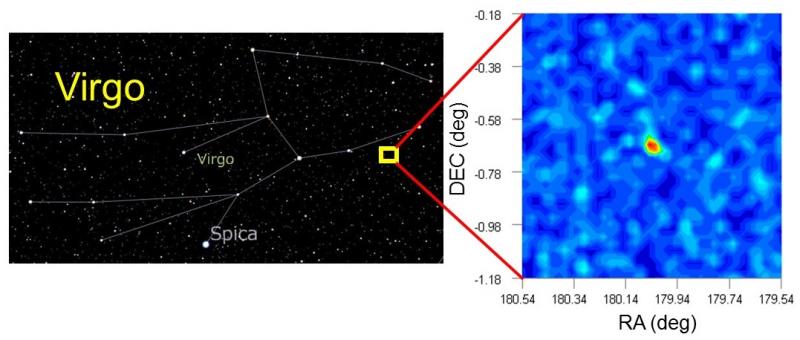November 22, 2016
Kavuli Institute for the Physics and Mathematics of the Universe
Led by researchers from Tohoku University, an international team including Kavli IPMU members Miho N. Ishigaki, Hitoshi Murayama, and Masahiro Takada, has found an extremely faint dwarf satellite galaxy of the Milky Way. The team's discovery is part of the ongoing Subaru Strategic Survey using Hyper Suprime-Cam. The satellite, named Virgo I, lies in the direction of the constellation Virgo. At the absolute magnitude of -0.8 in the optical waveband (Note), it may well be the faintest satellite galaxy yet found. Its discovery suggests the presence of a large number of yet-undetected dwarf satellites in the halo of the Milky Way and provides important insights into galaxy formation through hierarchical assembly of dark matter.

Currently, some 50 satellite galaxies of the Milky Way have been identified. About 40 of them are faint and diffuse and belong to the category of so-called "dwarf spheroidal galaxies." Many recently discovered dwarf galaxies, especially those seen in systematic photometric surveys such as the Sloan Digital Sky Survey (SDSS) and the Dark Energy Survey (DES) are very faint with absolute luminosity in the optical waveband below -8 magnitude. These are so-called "ultra-faint dwarf galaxies." However, previous searches made use of telescopes with a diameter of 2.5 to 4 meters, so only satellites relatively close to the Sun or those with higher magnitudes were identified. Those that are more distant or faint ones in the halo of the Milky Way are yet to be detected.
The combination of the large aperture of 8.2-meter Subaru Telescope and the large field-of-view Hyper Suprime-Cam (HSC) instrument is significant in this study. It enables an efficient search for very faint dwarf satellites over large areas of the sky.
Using HSC to Trace Galaxy Formation
Formation of galaxies like the Milky Way is thought to proceed through the hierarchical assembly of dark matter, forming dark halos, and through the subsequent infall of gas and star formation affected by gravity. Standard models of galaxy formation in the context of the so-called cold dark matter (CDM) theory predict the presence of hundreds of small dark halos orbiting in a Milky Way-sized dark halo and a comparable number of luminous satellite companions. However, only tens of satellites have ever been identified. This falls well short of a theoretical predicted number, which is part of the so-called "missing satellite problem." Astronomers may need to consider other types of dark matter than CDM or to invoke baryonic physics suppressing galaxy formation to explain the shortfall in the number of satellites. Another possibility is that they have seen only a fraction of all the satellites associated with the Milky Way due to various observational biases. The issue remains unsolved.
One of the aims of the Subaru Strategic Survey using HSC is to increase observations in the search for Milky Way satellites. The early data from this survey is what led to the discovery of Virgo I. This program will continue to explore much wider areas of the sky and is expected to find more satellites like Virgo I. These tiny companions to be discovered in the near future may tell us much more about history of the Milky Way's formation.
For more information, please see the press release of the National Astronomical Observatory of Japan Hawaii Observation.
Note:
1. For Comparison, the abolute magnitude in visible waveband for M31 (Andromeda Galaxy), Large Magellanic Cloud, and Small Magellanic Cloud are -21.77, -18.35 and -17.02, respectively, according to NASA/IPAC Extragalactic Database (http://ned.ipac.caltech.edu).
Paper Details:
Journal:
The Astrophysical Journal (ApJ, 832, 1)
Title: A New Milky Way Satellite Discovered In The Subaru/Hyper Suprime-Cam Survey
DOI: 10.3847/0004-637X/832/1/21 (2016/11/14)
Research Team:
Daisuke Homma (Tohoku University, Japan), Masashi Chiba (Tohoku University, Japan), Sakurako Okamoto (Shanghai Astronomical Observatory, China), Yutaka Komiyama (National Astronomical Observatory of Japan (NAOJ), Japan), Masayuki Tanaka (NAOJ, Japan), Mikito Tanaka (Tohoku University, Japan), Miho N. Ishigaki (Kavli Institute for the Physics and Mathematics of the Universe (Kavli IPMU, WPI), University of Tokyo, Japan), Masayuki Akiyama (Tohoku University, Japan), Nobuo Arimoto (Subaru Telescope, NAOJ, USA), Jose A, Garmilla (Princeton University, USA), Robert H. Lupton (Princeton University, USA), Michael A. Strauss (Princeton University, USA), Hisanori Furusawa (NAOJ, Japan), Satoshi Miyazaki (NAOJ, Japan), Hitoshi Murayama (Kavli IPMU, WPI, University of Tokyo, Japan), Atsushi J. Nishizawa (Nagoya University, Japan), Masahiro Takada (Kavli IPMU, WPI, University of Tokyo, Japan), Tomonori Usuda (NAOJ, Japan), Shiang-Yu Wang (Institute of Astronomy and Astrophysics, Academia Sinica, Taiwan)
Paper abstract:
The Astrophysical Journal Letters
http://iopscience.iop.org/article/10.3847/0004-637X/832/1/21
arXiv.org: Pre-print
https://arxiv.org/abs/1609.04346
Contact:
John Amari
Press Office
Kavli Institute for the Physics and Mathematics of the Universe
Institutes for Advanced Study
The University of Tokyo
TEL: +81-04-7136-5980
E-mail: press_at_ipmu.jp
*change _at_ to @






